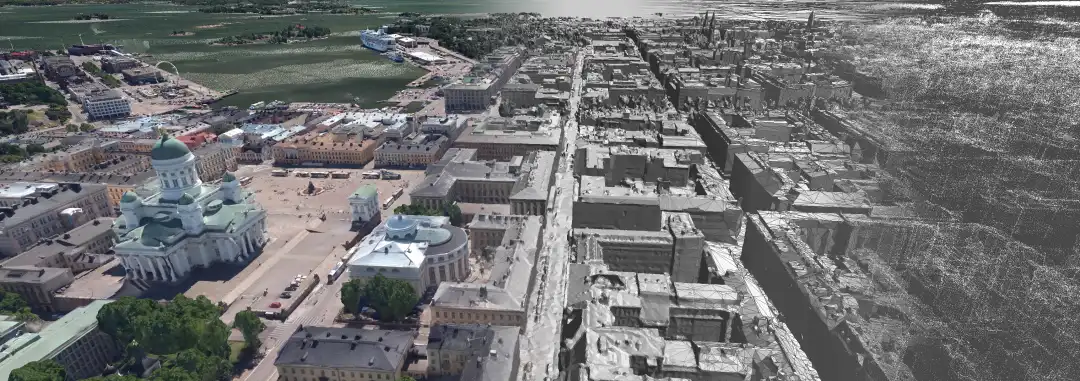Smart City - why it's more than a buzzword
Together with Timo Tuukkanen - Director of Strategic Partnerships at Bentley Systems, we tried to unveil what “Smart City” concretely means for cities, companies and, most importantly, citizens.
30 June 2022Ask a question

Defining a Smart City
For most people who first approach “smart cities”, understanding its actual meaning is difficult as it is frequently used like an umbrella term to define anything smart and digital in cities.
At its core, a smart city means turning cities into “data collection machines” so cities can connect and simplify the different infrastructures. Hence, offering cost-efficient and better services. This way, you can enable data-driven decisions in planning and operations.
This shift in thinking about cities is crucial for two main reasons:
- Climate change: this alone should be a good reason to make a city “smart”. Collecting data help cities to reduce greenhouse gas mobility emissions, electricity and heat consumption and, ultimately, become more resilient towards changing climate;
- Increasing population: From 2021 to 2050, 2.24 billion more people are expected to live in urban areas, meaning 200.000 new citizens every day (source). To serve these people, services need to be scalable and resilient.
The role of Digital Twins
Cities are running on established processes and regulations, which makes innovative solutions hard to implement. A Digital twin allows cities to digitalise any infrastructure in a unified manner. Hence, you can connect all possible information from sensors and databases into an unified structure, allowing you to simplify and improve every process.
For example, to choose the right locations for installing new solar panels, you could connect information about the ownership of the lands with geospatial information (e.g. imagery) to understand where the sun will reach the roofs most effectively, etc.
All in all, it can provides answers to three major questions:
- Mobility: how do I move people?
- Energy: how do I optimise the energy available?
- Climate resilience: how do I protect the city from catastrophic events?
Sensors & Digital Twins
Helsinki is a virtuous example of implementing a smart city strategy using digital twins. In fact, it has built a 3D model of the city that serves as a unified decision-making platform for development decisions, as an alternative to cadastral maps or text data. As such cameras, LiDAR, etc. are fundamental to building these models (in their case, aerial imagery).

However, the use of sensors is highly dependent on the use case. For instance, you can use video cameras to monitor the traffic flow within specific areas or moments of the day/month/year to reduce traffic or enlarge roads in the busiest areas. Also, you can optimise water utility operations using pressure/temperature sensors. Bottlenecks of creating a Smart City All of this sounds beneficial for any city. But why isn't every city investing in this direction?
Whilst sensors and software solutions are practically accessible to anyone, a tailor-made digitalization strategy is required to define the best approach for each city. This requires particular skill sets that mostly big cities have the resources to acquire.
Another issue is that, too often, such projects run as a pilot project for specific districts or for a limited amount of time. Outdated and restricted datasets lose value, making money not well spent. Successful cities are putting city-wide digitization projects into production, along with keeping the data up-to-date.
Smart Cities & Data Privacy
Applications of data are limitless. For example, construction sites might require frequent collection of images or videos to understand the changes on the site itself. You could use such data to train a machine learning model to detect whereas there’s someone who doesn’t wear the security helmets and improve overall security on the construction site. However, this model might imply facial recognition.
Zooming out, where do you draw the line between using the data efficiently and invading individuals’ privacy?
Data has improved officials’ decision-making and operations. In fact, many cities are investing into open data to improve their services and stimulate innovation. Nevertheless, increasing strict regulations on data usage (e.g. GDPR, CCPA, APPI etc.) and citizens’ sentiment about their data and privacy is forcing officials to invest into specific measures (e.g. data anonymization). This would avoid situations where personal data is abused, stolen or leaked.
Selling Smart Cities
Most of the smart city solution providers are not communicating the possibilities to generate political consensus through innovation, instead focusing on a technical target audience in cities, who too often has no influence on investment decisions.
Moreover, cities' employees - especially in the older range - are usually hesitant to change their work tools. Instead of forcing this change, cities need to motivate, educate and get employees excited of using the newest technology implemented by the city.
In summary
Cities need to position their cities as a good place to live, innovate, etc. To do so, they will need to:
- Store: collect and connect as many data points as possible to improve its services;
- Protect: make sure that data are secured;
- Update: keep the data up-to-date to maintain their relevance and efficiency
This article is based on the recorded interview with Timo Tuukkanen - Director, Strategic Partnerships at Bentley Systems. On behalf of the Celantur team, we would like to thank him for sharing his knowledge and insights.
Ask us Anything. We'll get back to you shortly